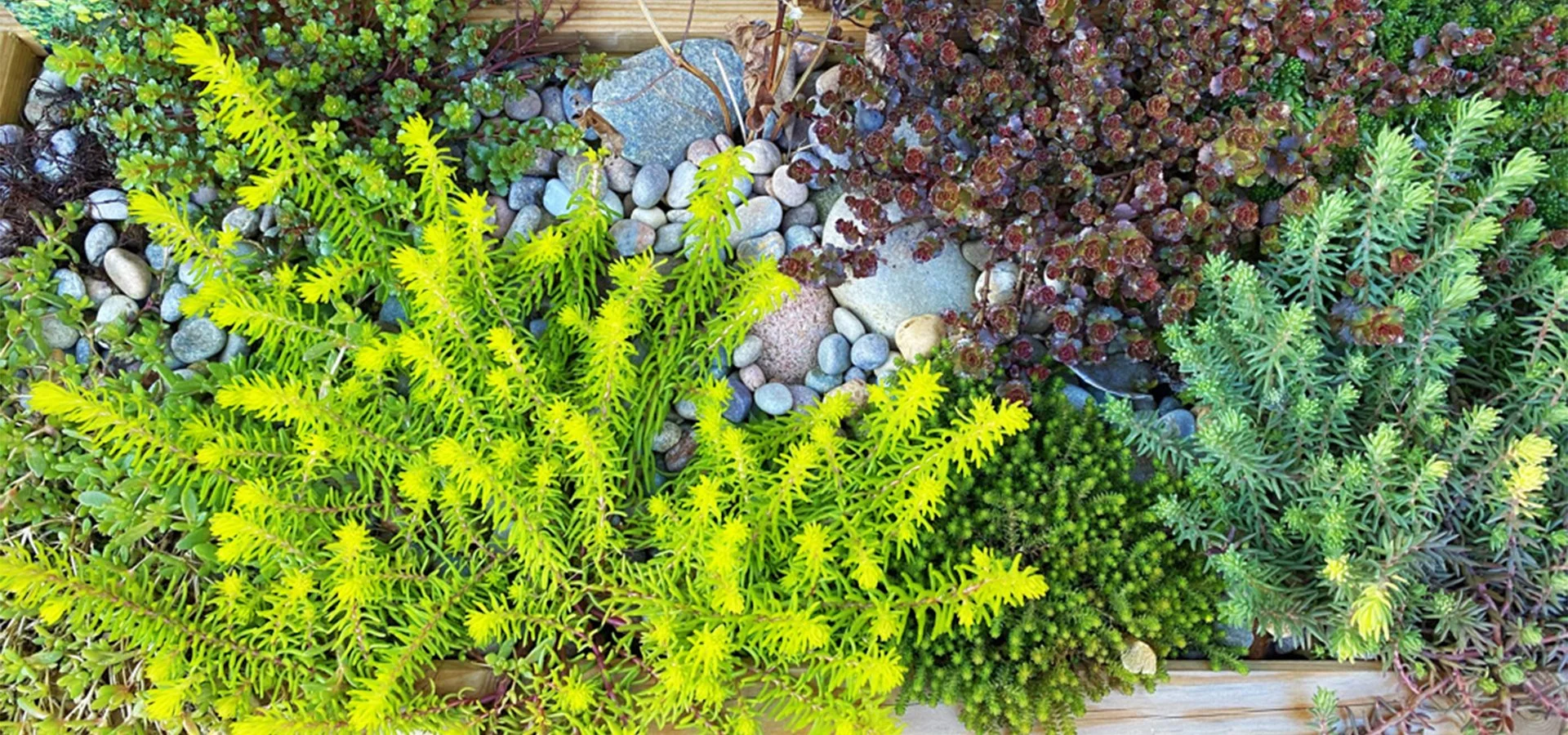Ten tips for potted plants in your garden.
Growing plants in pots and containers is a joy no gardener should deny, and our ten tips for potted plants will help.
Container gardening doesn’t have to be a pile of random plants shoved in a plastic tub and dumped on the corner of a patio.
There is so much more you can achieve with a pot other than a jarring display of flower vomit!
Why have pots?
Pots and containers have many uses in the garden, they are portable ecosystems which enable gardeners to cheat.
With a pot you can create new environments alien to your soil and climate. Dazzling displays are easily achieved with a little planning and a soupçent of hard work.
All you need is a pot and our top ten tips for potted plants in your garden.
1: The right place
Every successful container begins with answering a few questions:
-
There is no point placing a pot with a shade loving plant in full sun, or vice versa.
Neither for that matter is there any point in placing a delicate plant in a wind tunnel, the results will be disappointing at least.
-
Hiding something unsightly
A beautiful view from a window
A statement at the end of a path or vista
-
Despite your best efforts and planning, sometimes pots need to be moved around.
This could be because:
As seasons change the spot becomes unsuitable
The plant doesn’t like it
You don’t like it
2: Choosing Plants
Almost all plants can be grown successfully in pots, afterall we buy them in pots from the supplier the majority of the time. Some plants perform better with their roots restricted e.g. Agapanthus.
When choosing plants, take care to check where and how they like to live as well as how fast will they grow.
It’s perfectly fine to wander around a Garden Centre grabbing whatever looks pretty to you, but please; at least do a little research before you snatch it from its happy home!
What you should not do, is choose a pot the same size as the one the plant has, or worse smaller.
If you follow the rest of our ten tips for potted plants all will be rosey!
3: Get the right compost
You have your pot, and you’ve chosen your plants, now you need to marry the two.
There are many brands and types of compost and growing media on the market. They come in colourful packaging and all promise miraculous results.
Whilst most of this is marketing hype there are some fundamental differences.
-
Like it says on the bag, this compost if for growing successful seeds and cuttings.
It has been sieved to make it fine, has very few nutrients (so as not to damage emerging young roots) and usually has sand or vermiculite (small light balls) to stop it compacting.
This is not suitable to grow anything else in!
-
Multi purpose compost is a good all rounder, it’s cheap and easy to use and perfectly suitable for most plant pots.
Look out for peat free versions, these are better for the environment and we all need more of that!
-
Ericaceous is an intimidating way of saying compost which is good for plants that like acid soil.
You would use this for Heathers (Erica, hence the name), Acers, Pieris, Azalea and Rhododendron to name a few.
However it’s more expensive than Multi Purpose so save the money and buy Ericaceous Plant Feed instead!
-
John Innes is a soil based compost made of fine loam instead of peat (environmentally dubious) or coir (coconut husk).
It’s great stuff and plants will thrive, it comes in three main types:
No1 for Seed and cutting
No2 for potting on
No3 for containers, shrubs and established plants
As well as Ericaceous
It is also extremely heavy, so if you need your pots to stand up in wind, go for this, but if you want to move them around, think again!
4: Plant arrangement
There are a number of ways to plant a pot, however to look their best, you need to consider what effect you are trying to achieve.
-
This is a good arrangement for a pot at the end of a path or in the middle of a bed or border (flower beds can be walked around, flower borders terminate with a fence or wall).
Put something tall in the middle, and arrange smaller plants (perhaps trailing) around the outside. This creates a tiered effect which is particularly impressive it the pot is tall, or on a pedestal.
Cordyline Australis and trailing bedding plants look particularly striking.
-
This arrangement is great for pots in corners, or troughs in front of fences and walls.
It adds a feeling of depth as well as height to the container.
-
There are always plants which don’t play well with others. They stand alone and proud, aware that they have achieved perfection. We think of such plants as specimens, and they make a statement all on their own.
Specimen plants are often shrubs or small trees, and should be treated as special.
Acer Palmatum (Japanese Maple) and Topiary balls or spirals spring to mind.
5: How to plant a pot
Before you tip the compost in and lob your plants on top, there are a couple of things to consider.
Make sure the pot has drainage holes (if not makes some, or get a different pot) and arrange some stones (or broken terracotta) over them to stop the holes bunging up.
Start with a layer of compost at the bottom of the pots, and place your plants on it, then carefully tip more compost around and firm them in. The compost should be firm not solid, and the plants should be well supported. Water well.
I always add a layer of gravel or pebbles on top, it looks nicer than bare compost, reduces weeds and stabilizes the compost when watering.
6: When to water?
Remember to water you pots regularly, this can often be daily in summer!
A rain shower or even a storm is not going to get you off the hook in summer, always check your pots:
Have a look at the plant and see if the leaves are drooping
Poke your finger in the compost and see if it’s moist
Rock the pot if you can, if it’s light it’s dry, if it’s heavy it’s wet.
All of these will also indicate over watering (just to be annoying) so it’s worth checking. If you encounter over watering, check the drainage holes aren’t blocked. Poke a cane in to try and release the blockage, tip the pot on its side to let the water out.
Always water when the sun is weakest, morning or evening, never water the leaves of a plant if you can avoid it, this can lead to scorching (leaves being burned by the sun) and consider investing in saucers to save water.
Avoid using a hose, as you can’t judge the amount you are giving.
We aim for a 10L watering can each for large pots (over 40cm diameter) or split between 3 or 4 for smaller pots.
7: Plant food and when to feed?
So you’ve planted your pot and stuck it somewhere nice. You water it when you remember what more can it want?
Well it may surprise you that after a month or so all the nutrients in the compost are spent!
“So what! you say, plants make their own food from the sun”
This is true, however plants get minerals and trace elements from the soil around them. They cannot do this in pots, and rely on you providing this.
Lacklustre growth, yellowing leaves and poor flowering are all signs of an undernourished plant.
There are a bewildering variety of feeds available for plants, however it’s really quite simple and many are designed to make your life easier.
-
Applied to the surface of the pot, this slowly releases into the compost over time as you water. It’s good for older plants and as an autumn feed.
The down sides are, it can look unsightly and sometimes smells.
-
This is a brightly coloured powder, which you mix in a watering can and apply directly to the pot (not the plant).
They all have different strengths so follow the instructions, and aim to feed your pots between watering every two or three weeks.
-
As with the multi purpose version, this should be applied every two weeks.
Ericaceous feeds will deal with common deficiencies which occur in acid loving plants.
Leaf yellowing is a sign of an Iron deficiency (occasionally magnesium). Ericaceous feed will prevent this, and is essential to healthy growth and flowering in Azaleas and Rhododendrons.
Infact as multi purpose and ericaceous feeds often cost the same, I only use Ericaceous on my plant pots.
-
There is nothing wrong with using this food for your containers as well, except where you should be using ericaceous feed.
I’m just glad you have decided to feed your plants!
8: Top dressing and re-potting
After a while it seems that compost shrinks and alot more of the pot is showing, this is perfectly normal.
Simply firm in a fresh layer of compost on top and you’re good to go, this is called top dressing.
If your plant has been in a pot for a long time, you may wish to pot it into a larger one.
Choose a pot that’s a couple of sizes bigger, make sure the pot has drainage holes and you’ve popped some broken terracotta or stones in the bottom so the holes don’t get bunged up.
9: Finishing touches
Finishing your pots and containers with a layer of gravel or pebbles not only makes them look nicer, it stops the compost drying out and reduces weeds.
It’s just good practice.
10: Protecting your plants and pots
Frost
The threat of frost can keep gardeners awake at night, particularly when all the lovely new growth is emerging in April and May.
So how do we protect our plants?
Move them somewhere sheltered, or into a greenhouse / cold frame
Cover with Frost Fleece
Frost Fleece is a fine fabric which you drape over or wrap plants with. Essentially it acts like a blanket and keeps the plants a few degrees warmer.
Fleece allows light through so you don’t necessarily have to take it on and off unless you want to.
How do we protect our pots?
Move them somewhere sheltered
Wrap with hessian, blankets or bubble wrap, don’t block drainage holes!
Don’t put bubble wrap or plastic directly onto plants it AMPLIFIES the effect of the cold!
Pests
There are many pests and diseases which strike plants, wether they are in pots or not.
Slugs and Snails
Aphids
Vine Weevil
Rust
Black spot
Powdery Mildew
to name but a few.
There are treatments for all of these, both chemical and natural, the topic is quite large and I will cover it in detail in my next blog.






